The Last Ride of the “Wild Child” North of Mojave, California February 26, 2006 Glory Days... Born in 1946, Terrance Henry "Terry" Fregly graduated from Lycoming College, with a Bachelor of Arts in business administration, in 1967, and was commissioned as an officer in the U.S. Air Force shortly afterwards. Serving as a pilot until 1971, he earned an M.B.A. from Florida State University that same 1971, and attended the University of Belgrade in Yugoslavia for his graduate studies. He became a real-estate developer, residing in Tallahassee, Florida, and was active in the aviation community. He was a member of the U.S. Air Force Association and a life member and past president of their Bud West Chapter. He also served as vice chairman of the Tallahassee Regional Airport Advisory Board from 1999 to 2002, and had also been on the advisory board of the Challenger Learning Center IMAX since 2000, and on the board of directors of the Clark Planetarium in Salt Lake City since 2002. With a passion for flying, he held a commercial pilot certificate, with a multiengine rating, had over 2,500 hours of flight time, and was known to fly an Aero Vodochody L-39 "Albatros", a Soviet-era primary jet trainer built in 1979, registered as N39DF, and nicknamed “Wild Child”. In the United States, only 90 of the Czechoslovakian-built jets were in private hands. But the “Wild Child” stood apart. It was a prolific racing plane – sporting a huge red “4” on its stark-white underbelly, and was the third top qualifier at the National Championships in 2004, finished Heat 1B in first place at a speed of 412.8 mph, and finished fifth in the Gold in 2005. Under the ownership of Mach 1 Aviation, the racer was used for various aerial services, including Jetcam movie photography and air combat simulation in major Hollywood motion pictures, such as Navy Seals, Air Force One, and Jarhead. Also, two pilots used N39DF to set a World's Speed Record between Los Angeles and Phoenix, a distance of 561.2 miles in 39 minutes, 58 seconds, according to the National Aeronautic Association. 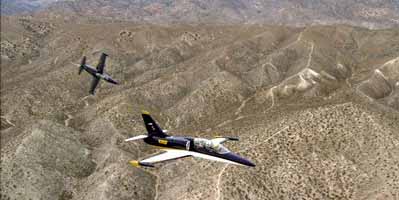 Lt. Col. Skip “Hoss” Robertson, a 43-year-old resident of Klamath Falls, Oregon, was a retired Air Force adviser and instructor pilot for the 173rd Fighter Wing of the Oregon Air National Guard at Kingsley Field, and had been a corporate pilot for Jeld-Wen since 2005. A 1985 graduate of the U.S. Air Force Academy, he began his flying career in the OV-10, serving in Korea for two years. He then flew the F-15 for 14 years including serving in Desert Shield and Desert Storm, and later flew F/A-18s. He held an airline transport pilot certificate with both multi-engine and glider ratings. Lt. Col. Skip “Hoss” Robertson, a 43-year-old resident of Klamath Falls, Oregon, was a retired Air Force adviser and instructor pilot for the 173rd Fighter Wing of the Oregon Air National Guard at Kingsley Field, and had been a corporate pilot for Jeld-Wen since 2005. A 1985 graduate of the U.S. Air Force Academy, he began his flying career in the OV-10, serving in Korea for two years. He then flew the F-15 for 14 years including serving in Desert Shield and Desert Storm, and later flew F/A-18s. He held an airline transport pilot certificate with both multi-engine and glider ratings.
Flying for the Movies... Early on the morning of Sunday, February 26, 2006, with “Hoss” in the front pilot's seat, and Fregly in the rear co-pilot's seat, the “Wild Child” took off from Van Nuys, California, to assist in the filming of scenes for an upcoming film, Succubus: Hell-Bent. The majority of the aerial filming that day was to take place in the mountains and hills northwest of the town of California City, where the cool air provided few clouds, and a rare day of 25 miles of flight visibility. The camera plane, a twin-engine Cessna 310, carried the producer-director and filmed the “Wild Child” for about a hour. During the filming, the director issued instructions to the Wild Child's flight crew, and they maneuvered their airplane in accordance to those directions. Throughout the flight, Robertson and Fregly discussed the safety of the flight. Although Robertson was clearly the more experienced pilot – Fregly was, afterall, the pilot-in-command for the flight. Robertson, however, described his role as simply “just here to be your little voice” and watch the various power and control settings of the jet. At around 8:25 AM, Fregly took the reins of the Wild Child, just in time for the director's final shot - a "sharp snap roll to the right and pull down out of frame." The L-39's flight crew acknowledged the order, and went to work on the maneuver. The Final Order... 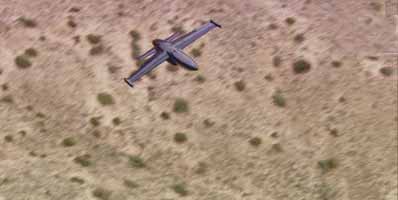 Starting at an altitude of 5,500 feet, Fregly responded by executing a 90-degree roll to the right and its nose fell below the horizon. But about a second thereafter, the airplane abruptly rolled further right to about 135 degrees of bank, and the nose dropped further as the airplane directly approached hilly terrain. Two seconds later, Fregly said, "I got it, I got it, I got it." Starting at an altitude of 5,500 feet, Fregly responded by executing a 90-degree roll to the right and its nose fell below the horizon. But about a second thereafter, the airplane abruptly rolled further right to about 135 degrees of bank, and the nose dropped further as the airplane directly approached hilly terrain. Two seconds later, Fregly said, "I got it, I got it, I got it."
Robertson replied, "Ease off" and then Fregly repeated Robertson's command. But then, four seconds later, the airplane began an abrupt left roll back to approximately 30 degrees of bank and, two seconds thereafter, the airplane rolled right again to about 45 degrees bank as the airplane continued to close on the side of a hill. During this time, Fregly stated, "I got it, ease off, ease off, okay." Four seconds later, during this attempted recovery from the near split "S" course reversal turn, the Albatros struck the underlying 3,100-foot elevation hillside in Kern County's Pine Tree Canyon, and cartwheeled for 800 feet in a ball of flames and slung debris. Both Robertson and Fregly were killed instantly. Sitting in Safety... The camera plane, as well as a camera mounted on the tail portion of the Wild Child, recorded both video and audio of the entire crash sequence. 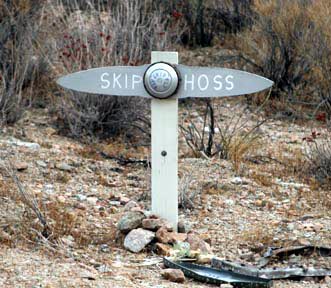 The National Transportation Safety Board (NTSB), in their investigation into the cause of the mishap found that no abnormalities in the L-39 were observed. They also noted, however, that the severity of the impact and fire damage to flight controls and system components precluded confirmation of their preimpact integrity. The examination of the remaining airframe and engine components, however, revealed no evidence of preimpact mechanical malfunction. The National Transportation Safety Board (NTSB), in their investigation into the cause of the mishap found that no abnormalities in the L-39 were observed. They also noted, however, that the severity of the impact and fire damage to flight controls and system components precluded confirmation of their preimpact integrity. The examination of the remaining airframe and engine components, however, revealed no evidence of preimpact mechanical malfunction.
The NTSB did more extensive usage of the camera plane's footage of the crash, as well as the usable footage filmed from the Wild Child. The crash saddened the Mojave aviation community as well as the jet warbird world. Robertson was remembered as “one of these guys that when you first meet him you like him. He's just a down to earth guy - he'd do anything for you.” The NTSB, in their final report, determined the probable cause of the accident to be the flight crew's failure to maintain terrain clearance during an intentionally performed course reversal turn at low altitude. Skip Hoss was buried at the U.S. Air Force Academy's cemetery near Colorado Springs, Colo. Fregly was buried in the Garden of Serenity at Culley's MeadowWood Memorial Park in Tallahassee, Florida. The Crash Site Today... Given the way the "Wild Child" impacted, the crash site is very elongated, and covers a distance of about 75 yards.  | 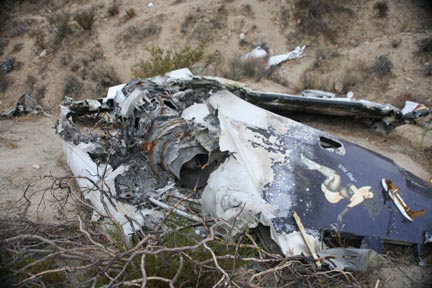 | | Near the impact point - much of the wreckage and debris has flowed down the wash nearby | The tail section of N39DF - note the distinctive artwork on the tail of the plane | 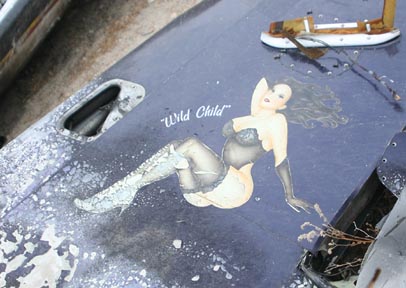 | 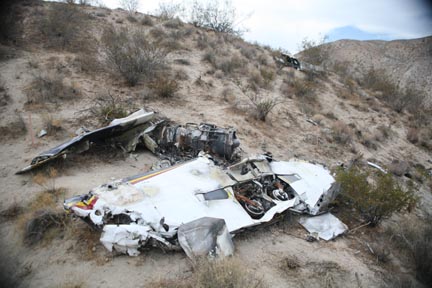 | | Close-up of Wild Child's tail art - damaged by the impact blaze, and exposure to the elements | Another view of N39DF's tal and carry-though section - note the landing gear well and jet engine | 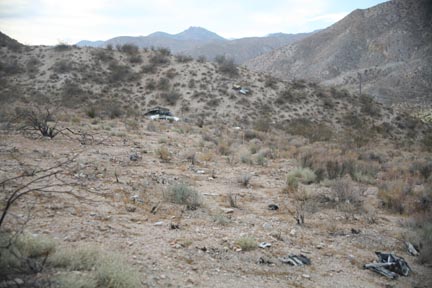 | 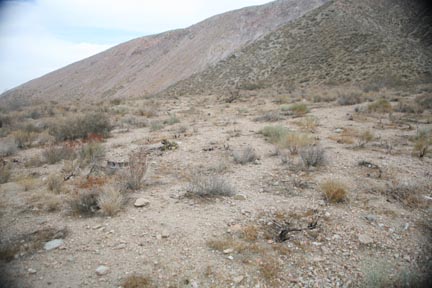 | | Looking down the plane's tumble path towards the tail section | Looking up the plane's tumble path towards the impact point |
|
